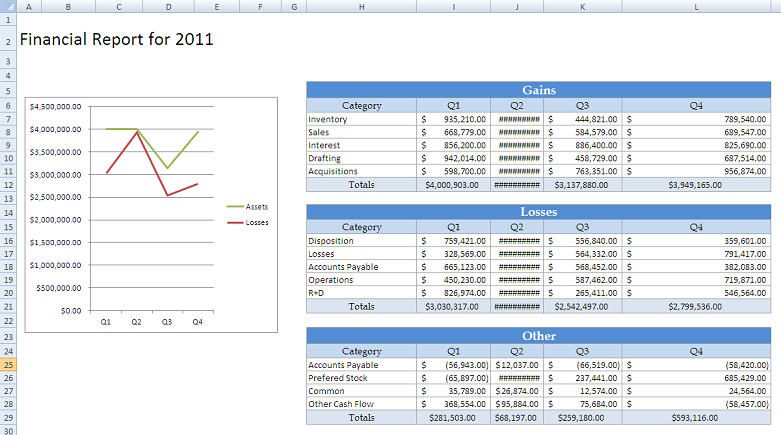...
| Info | ||
|---|---|---|
| ||
In the downloadable TODO ADD FILE REFERENCE, there is a completed template file located in ComleteFinancialReport/templates/Part1_Financial_Template.xlsx. |
Getting Started
...
4. Call Area.AutoFitHeight() and Area.AutoFitWidth() to set the column and row height correctly. . AutoFitWidth sets the column width to fit the widest populated cell in the column. AutoFitHeight sets the row height to highest populated cell in the row. In this snippet, the area is Worksheet.PopulatedCells, which returns an area containing all populated cells.
...
The final output should look something like this: 
Final Code
| Code Block |
|---|
//Instantiate the template object ExcelTemplate XLT = new ExcelTemplate(); //Open the file XLT.Open(Page.MapPath("//templates//Part1_Financial_Template.xlsx")); //Create data binding properties DataBindingProperties bindingProps = XLT.CreateDataBindingProperties(); //Get the data from the CSVs. More info about the generic parser is available //in the project and in the tutorial above. DataTable dtAssets = GetCSVData("//data//Assets.csv"); DataTable dtLosses = GetCSVData("//data//Losses.csv"); DataTable dtOther = GetCSVData("//data//Other.csv"); //Declare the row data. This tutorial uses a single item array to demonstrate the //optional modifier string[] headerValues = { "2011" }; string[] headerNames = { "FiscalYear" }; //Bind each datatable XLT.BindData(dtAssets, "Assets", bindingProps); XLT.BindData(dtLosses, "Losses", bindingProps); XLT.BindData(dtOther, "Other", bindingProps); //Bind the single row data XLT.BindRowData(headerValues, headerNames, "Header", bindingProps); //Call process to import data to file XLT.Process(); //Post-Processing ExcelApplication *This next section handles the post-processing*/ //Instantiate ExcelApplication ExcelApplication XLA = new ExcelApplication(); //Open the XLT object as a new workbook Workbook wb = XLA.Open(XLT); //Get the first worksheet Worksheet ws = wb.Worksheets[0]; //Set the autofit width and height ws.PopulatedCells.AutoFitWidth(); ws.PopulatedCells.AutoFitHeight(); //Save the file XLA.Save(wb, Page.Response, "temp.xlsx", false); |
...